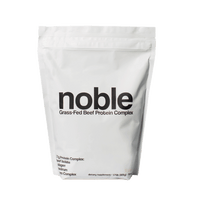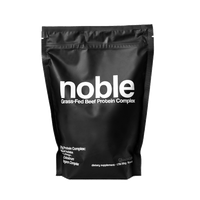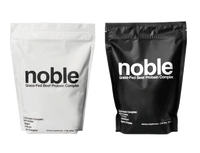
Difference of Permaculture vs Regenerative Agriculture
Share
Do you need clarification about permaculture and regenerative agriculture? You're not alone.
Many people mix up these two sustainable farming techniques since both aim for a more eco-friendly approach towards food production.
This blog post will provide clarity, giving you an in-depth comparison between these practices showing their unique benefits and differences.
Let's dive into the world of sustainable farming!
Key Takeaways
- Both permaculture and regenerative agriculture aim to be eco-friendly. They help build healthy soil and boost biodiversity.
- Permaculture focuses on linking people with the landscape. It uses animals and trees in farming for renewal, not depletion.
- Regenerative agriculture works to restore soil health. It also captures carbon from the air, which can help fight climate change.
- Neither method is 'better.' They both are essential for sustainable farming and can work together well.
Comparing Permaculture and Regenerative Agriculture
Let's delve into the similarities and distinctions between permaculture and regenerative agriculture, two highly effective sustainable farming methods.
Despite having a shared goal of fostering environmentally friendly practices, they each hold unique characteristics that set them apart - let's lay them out in a comparative table for an easier understanding.
Similarities
Both Permaculture and Regenerative Agriculture strive for the same goals. They prioritize organic methods to build soil health by shunning harmful synthetic chemicals like pesticides or fertilizers. (1)
Biodiversity is a shared aim, leveraging it to boost ecosystem services.
Cover crops are a common feature in both approaches, instrumental in maintaining soil health by increasing organic matter and minimizing soil structure disturbance.
These farming techniques aim to tackle global challenges such as climate change and water security while addressing hunger and protecting threatened species.
Distinctions
Permaculture and regenerative agriculture, both environmentally friendly farming methods, carry distinct characteristics.
Focused on rebuilding organic matter and restoring degraded soil biodiversity, regenerative agriculture decreases tillage and reduces artificial fertilizers.
It promotes biodiversity through cover crops. On the other hand, permaculture strives to create agriculturally productive ecosystems that harmonize landscape and people.
The ultimate goal of regenerative agriculture is resource improvement rather than depletion. (3)
In contrast to this, permaculture designs systems mimicking natural ecosystems with principles like observation and ecological design at its core.
Permanence in agricultural systems is a primary focus in permaculture achieved through perennial crops and animals.
The following table provides a straightforward comparison between permaculture and regenerative agriculture, highlighting their respective focuses.
| Aspect | Permaculture | Regenerative Agriculture |
|---|---|---|
| Primary Goals | Integrates landscape and people in a harmonious way. | It aims to reverse climate change and restore soil biodiversity. |
| Inspiration | Derives from natural processes and existing ecosystems. | Centers on rehabilitating and enhancing a farm's ecosystem. |
| Soil Health | Promotes soil health, recognizing limits to system productivity. | It also focuses on soil health, using carbon sequestration as a critical strategy. |
Whether you are a meat lover or following a carnivore diet, understanding these methods can guide your food choices toward more sustainable options.

Benefits of Permaculture
Permaculture offers many benefits, such as sustainable livestock management and agroforestry implementation.
You optimize land usage by incorporating livestock into your system through permaculture design to promote renewal instead of depletion.
Agroforestry, another hallmark of permaculture, combines trees with crops or livestock in a mutually beneficial relationship.
Cattle shade under trees while their trampling and manure improve soil quality for the tree's growth, an example of interconnected elements working seamlessly within the ecosystem.
Sustainable Livestock Management
In the realm of sustainable farming, livestock management takes center stage. Sustainable
Livestock Management involves utilizing eco-friendly practices that ensure animal health and productivity while conserving resources.
The approach declares war on harmful synthetic products, favoring natural methods; these lead to healthier soil and food for meat lovers and followers of carnivore diets.
Practices such as crop rotation play an integral role in enhancing soil fertility.
It's not just about raising animals organically but integrating them holistically into the agroecosystem for maintaining biodiversity.
This enriches our ecosystem with improved resilience to climatic changes, vital components within permaculture philosophy, and regenerative agriculture practice.
Agroforestry Implementation
Agroforestry implementation entails combining trees, crops, and livestock in a single farming system.
This intricate blend of permaculture can produce a diverse yield while promoting soil health and biodiversity.
From small backyard gardens to expansive farms, anyone can reap the benefits of this method.
The practice aligns with tackling global climate change and endangered species protection by creating agriculturally productive ecosystems that harmonize landscape integrations with human activities.
It fosters ecosystem resilience and biodiversity through interconnected elements, waste recycling, and resource conservation.
Indeed, it's more than just planting trees; it’s about cultivating diversity for long-lasting environmental well-being.

Benefits of Regenerative Agriculture
Regenerative Agriculture optimizes soil health, resulting in increased crop yields.
It encourages the process of carbon sequestration, capturing and storing atmospheric carbon dioxide within the farm's ecosystem.
This method improves water resilience and boosts crop nutrient density, aiding your overall farming success.
Carbon Sequestration
Regenerative agriculture offers a remarkable solution to capture and store carbon, known as carbon sequestration.
Carbon stored in the soil rather than becoming atmospheric CO2 gas has profound implications for fighting climate change.
This process involves growing plants that absorb carbon dioxide through photosynthesis and convert it into organic matter in the soil. (2)
Regenerative agriculture practices, such as minimized tillage, cover cropping, crop rotation, and composting, enhance soil fertility and effectively lock up carbon underground.
This approach can reverse global warming trends while increasing crop yields and water resilience–a win-win for everyone, including meat lovers keen on sustainable farming methods. (4)
Improved Soil Health
Regenerative agriculture packs a powerful punch for soil health. This farming method rebuilds organic matter and boosts soil biodiversity, leading to more vital, healthier crops.
Practices like reduced tillage and cover cropping guard against unnecessary soil disturbances.
The result? Long-term carbon storage that helps fight climate change.
Meanwhile, permaculture- a sustainable agricultural design system- prioritizes healthy dirt by creating holistic ecosystems where nutritious soils thrive naturally.
So whether you choose grass-fed beef from regeneratively managed cows or veggies from a permaculture garden, your diet choices improve soil health worldwide.

Permaculture vs Regenerative Agriculture: Which is Better?
In this section, we'll dissect the effectiveness of both permaculture and regenerative agriculture in promoting sustainability.
You will get to understand their respective impacts on climate change.
It's about something other than 'better,' as both have significant roles in sustainable farming.
Instead, let's explore how these approaches can complement each other for a more eco-friendly and resilient agricultural system.
Effectiveness in Promoting Sustainability
Permaculture shines in promoting sustainability by creating self-sufficient systems.
It integrates natural processes and existing ecosystems, yielding a diverse system that encourages renewable resource use, energy conservation, waste utilization, and ecosystem enhancement.
Unlike traditional farming methods that deplete soil fertility over time, permaculture promotes improved soil health for sustained crop yields.
In contrast, regenerative agriculture stands out with its focused goal of improving resources rather than depleting them.
Practices such as reducing tillage, using cover crops for nutrient enrichment, and carbon sequestration emphasize restoring degraded soil biodiversity.
The outcomes?
Healthier soils, higher nutrient density in food produced, and increased water resilience, all while reversing climate change effects by rebuilding organic matter in the soil—now that's practical sustainability!
Impact on Climate Change
Regenerative agriculture and permaculture both play a vital role in combating climate change.
These farming methods lead to increased carbon sequestration, an essential process that removes harmful carbon dioxide from the atmosphere.
Regenerative agriculture techniques restore degraded soil biodiversity, resulting in healthier soil capable of storing more carbon for more extended periods.
On the other hand, permaculture's focus on harmonious landscape integration decreases reliance on environmentally damaging practices.
This method significantly reduces greenhouse gas emissions contributing to global warming by minimizing energy consumption and waste production.
Both strategies offer practical ways to mitigate environmental harm while promoting sustainable food production systems. (5)
With their combined efforts, we can positively impact global climate preservation.
Conclusion
Navigating the realms of permaculture and regenerative agriculture can feel like a journey through two intertwined forests, each with its own set of wonders.
While both challenge the norms of traditional farming, they champion a harmonious dance between sustainable food production and ecosystem vitality.
Your path?
It hinges on your aspirations, the tools at your disposal, and your dedication to nurturing our Earth.
If you want to further align with these sustainable principles, consider integrating Noble Origins' Organ Blend and Beef Isolate Protein with Organs into your regimen.
Crafted with the essence of regenerative sourcing in mind, these supplements bolster your health and resonate with the ethos of both permaculture and regenerative agriculture.
Dive deep, make informed choices, and let's co-create a greener future.
FAQs
What distinguishes permaculture from regenerative agriculture?
Permaculture, created by Bill Mollison, designs sustainable ecosystems. Regenerative agriculture focuses on restoring soil health and biodiversity.
How does permaculture enhance sustainable farming?
Permaculture uses nature-aligned principles like 'Observe and Interact' and 'Catch and Store Energy' to boost ecosystem health.
Can regenerative agriculture improve crop yields?
Yes, regenerative practices enhance soil health, increasing yields, and ecosystem vitality.
Are there permaculture principles for gardening?
Yes, principles like 'Observe and Interact' guide eco-friendly gardening, promoting biodiversity.
Is soil erosion addressed in regenerative agriculture and permaculture?
Both prioritize soil health, using methods like cover crops to combat erosion effectively.
Do these farming methods support social responsibility?
Yes, both methods emphasize sustainable, eco-friendly practices, enhancing social responsibility.
Related Studies
- A study published by the Journal of the International Society of Sports Nutrition. The study found that a ketogenic diet, which is high in fat and low in carbohydrates, can improve endurance performance in off-road cyclists
- A study published by the University of Hawaii Pressbooks. The study outlines the essential roles of proteins in the body, including building and repairing tissues, producing enzymes and hormones, and maintaining proper pH balance in the blood.
- A study published by The Elm at the University of Maryland, Baltimore. The study discusses how age and physical activity influence protein and fat requirements, with older adults requiring more protein to maintain muscle mass and physical function.
- A study published by Purdue e-Pubs. The study found that higher protein intake promotes daily satiety during weight loss, reducing feelings of hunger and increasing feelings of fullness.
- A study published by Harvard Health. The study explores how genetics can influence the body's response to different levels of dietary fat, with certain genetic variations affecting the risk of obesity and metabolic disorders.



